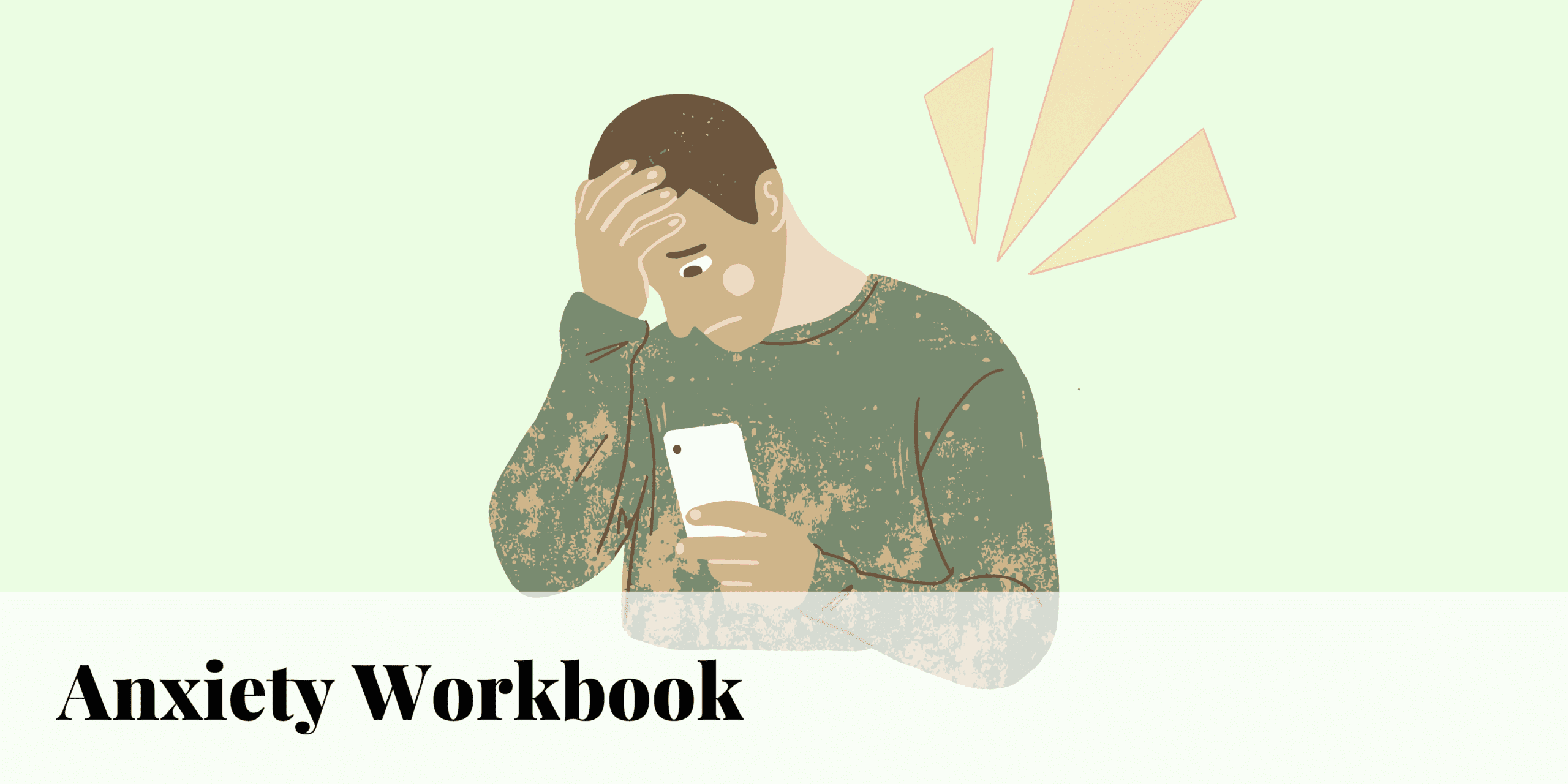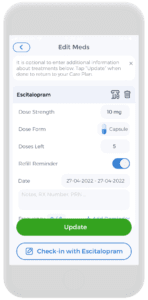
An anxiety workbook is a form of self-help intervention that is best to help bridge the gap between therapies and medications. Many studies are trying to determine the efficacy of “acceptance-based behavioral therapy” delivered in a self-help format (7). However, despite these controlled studies on topics like “an anxiety workbook” or an “anxiety and phobia workbook” are not heavily studied as other diseases, patients are still encouraged to participate (in conjunction with other therapies) (1). Learning what may trigger the anxiety in an anxiety workbook or anxiety worksheets can help identify those triggers and help manage them accordingly (8).
What is an Anxiety Workbook?

For example, as illustrated in the picture on the left, a simple diary function on the platform is a quick example of how easy it will be. Use it every day to write down whatever you wish. Perhaps possible triggers that you noticed before your anxiety attack. Or a method that was discussed in therapy that helped ease the anxiety. The possibilities are endless!
This way, it is not only digitalized but completely catered to you. A physical book is hard to carry around. Imagine trying to stuff a journal in a back pocket or a purse. And you can’t forget about the pen! Forget it…This is a new digital approach for all the data entries in your personalized Anxiety and Phobia Workbook. Also, conveniently secure and private. Score!
Anxiety Disorders
There are many anxiety disorders listed in the DSM-5 (Diagnostic and Statistical Manual of Mental Disorders- fifth edition currently) which is the “book of diagnosis” for the field of psychiatry (1,2). In order to be diagnosed with a specific kind of anxiety disorder, certain criteria need to be met. Let’s briefly explore all the anxiety disorders listed directly in the DSM-5.
Separation Anxiety Disorder
“An individual with separation anxiety disorder displays anxiety and fear atypical for his/her age and development level of separation from attachment figures. There is persistent and excessive fear or anxiety about harm to, loss of, or separation from attachment figures” (2).
Selective Mutism
“This disorder is characterized by a consistent failure to speak in social situations where there is an expectation to speak even though the individual speaks in other circumstances, can speak, and comprehends the spoken language. The disorder is more likely to be seen in young children than in adolescents and adults”(2).
Specific Phobia
“Individuals with specific phobias are fearful or anxious about specific objects or situations that they avoid or endure with intense fear or anxiety. The fear, anxiety, and avoidance are almost always immediate and tend to be persistently out of proportion to the actual danger posed by the specific object or situation. There are different types of phobias: animal, blood-injection-injury, and situational”(2).
For example: Agoraphobia = “Individuals with this disorder, are fearful and anxious in two or more of the following circumstances: using public transportation, being in open spaces, being in enclosed spaces like shops and theatres, standing in line or being in a crowd, or being outside of the home alone. The individual fears and avoids these situations because he/she is concerned that escape may be difficult or help may not be available in the event of panic-like symptoms, or other incapacitating or embarrassing symptoms (e.g., falling or incontinence)” (2).
Social Anxiety Disorder
Panic Disorder
Generalized Anxiety Disorder
Substance/Medication-Induced Anxiety Disorder
Anxiety Disorder Due to Other Medical Conditions
Epidemiology
Anxiety is one of the most common psychiatric disorders in the general population. Unfortunately, a lot of people fail to get help or clinicians may miss the diagnosis. Therefore, it is difficult to determine the true numbers of how many people anxiety may affect.
Meanwhile specific phobia is the most common. Social anxiety disorder is the next most common, followed by panic disorder and GAD. On the other hand, the least common anxiety disorder is agoraphobia. Furthermore, anxiety disorders occur more frequently in females than in males, with an approximate 2:1 ratio (1,2)!
Age of onset (for Children, Teens & Adults)
The age of onset for anxiety disorders will differ for children or teens or adults. For example, Separation anxiety disorder and specific phobia usually start during childhood, with a median age of onset of 7 years. For teens, the age of onset for SAD is usually around 13, agoraphobia without panic attacks (around 20 years), and panic disorder (24 years) (1,2).
Usually, GAD may start later in life. Anxiety disorders tend to run a chronic course, with fluctuating symptoms. After the age of 50, there is a decrease in the prevalence of anxiety disorders that have been in epidemiological studies. However, GAD is the only anxiety disorder that is still common in people ages 50 and up1,2).
Anxiety Symptoms
These anxiety symptoms are considered “pathological” and are broken down into categories (as a way to sum up anxiety symptoms as a whole, instead of the DSM-5 method of breaking down all the different types of different anxiety disorders).

- Cognitive symptoms: For example fear of losing control/physical injury or death/”going crazy”/negative evaluation by others; frightening thoughts, mental images, or memories; perception of unreality or detachment; poor concentration, confusion, distractible; narrowing of attention, hypervigilance for threat; poor memory; and difficulty speaking (2)
- Physiological symptoms: For example increased heart rate, palpitations; shortness of breath, rapid breathing; chest pain or pressure; choking sensation; dizzy, light-headed; sweaty, hot flashes, chills; nausea, upset stomach, diarrhea; trembling, shaking; tingling or numbness in arms and legs; weakness, unsteadiness, faintness; tense muscles, rigidity; and dry mouth (2)
- Behavioral symptoms: For example avoidance of threat cues or situations; escape, flight; pursuit of safety, reassurance; restlessness, agitation, pacing; hyperventilation; freezing, motionless; and difficulty speaking (2)
- Affective symptoms: For example a nervous, tense, wound up; frightened, fearful, terrified; edgy, jumpy, jittery; and inpatient and frustrated (2)
In other words, recording such symptoms will become a breeze when using the CareClinic Platform’s Symptoms Tracker.
Medications for Treatment.

The CareClinic Platform allows for the easy recording of all medications, if needed and prescribed by the licensed physician (or healthcare team). It even allows refill reminders! Therefore, do not miss another dose as well as help with the reduction of tasks on the brain! Sometimes, life gets too busy and it can become difficult to juggle it all…
Other medications that are best for anxiety are (but are not a limit to):
-
Tricyclic antidepressants (higher side effect profile) (2)
-
Benzodiazepines (short-term management of anxiety) (2)
-
Buspirone (mild tranquilizer) (2)
-
Beta-blockers (2)
Make sure to speak to a licensed physician or healthcare team about incorporating medication into the regimen.
Psychotherapy/CBT for Anxiety

One of the most effective forms of psychotherapy is cognitive-behavioural therapy (CBT)* for all ages (3). CBT for anxiety is a “structured, goal-oriented, and didactic form of therapy that focuses on helping individuals identify and modify characteristic maladaptive thinking patterns and beliefs that trigger and maintain symptoms”. For instance, CBT for anxiety will focus on “building behavioural skills so that patients can behave and react more adaptively to anxiety-producing situations”(2).
Using the CareClinic Platform’s Therapy Tracker, keeping track and recording all sessions have never been simpler. For instance, recording all sessions as well as personalized notes below- to visualize the progress!
*Some CBT simple strategies are available in pdf form as printing from the pdf version can be utilized at home/clinic/hospital purposes. Above all, please note that CBT should with a professional before simply using a PDF version of its concept.
Prognosis
Anxiety disorders have been noted to have very high morbidity, including issues with substance abuse, alcoholism, and major depression (1,2). A lot of the time, depression and anxiety can go hand-in-hand. It is important to screen for both.
For instance, constant anxiety can increase the risk of adverse cardiac events. On the other hand, anxiety can impact social relationships. Therefore, this can worsen the quality of life. Severe anxiety has also been linked to high rates of suicide, and people should be monitored by their healthcare team (1,2). Those difficult questions should be brought up.
Pregnancy & Postpartum
Pregnant patients and women in the postpartum period deserve their own separate section. Here we are.
For example, depression, stress, and anxiety occurring during pregnancy and postpartum are collectively termed ‘psychological distress’. These are quite common in pregnancy and postpartum periods (5), which is why it is important to discuss mental health with everyone. For example FYI: “Pre” refers to BEFORE the pregnancy, “-Peri” refers to DURING pregnancy, and postpartum refers to after the baby has delivered.
Above all, when a mother experiences prenatal psychological distress, they are more likely to be with postnatal psychological distress measures. Therefore, interventions during pregnancy may reduce the risk of postpartum psychological distress (5).
In other words, anxiety disorders are common during the perinatal period, with reported rates of obsessive-compulsive disorder and generalized anxiety disorder being higher in postpartum women than in the general population. This perinatal context of anxiety disorders will present unique issues for detection and management and for further studies (4,6).
In addition, the postpartum period is known as a time of vulnerability, particularly to postpartum depression. In contrast, the prevalence and clinical presentation of anxiety disorders during pregnancy and the postpartum period have received little research attention and should be kept in mind for the future (6).
How to Reduce or Control Anxiety
Anxiety Relief
For instance, to reduce or control or stop anxiety…requires a million-dollar answer, as a result, there are no right answers. In other words, in combination with medication and therapy, incorporating self-help interventions can be helpful such as the Anxiety Workbook. Today, try the digital “Anxiety and Phobia Workbook” amongst your daily routines!
Other Coping Mechanisms
Other coping mechanisms will be brought to attention; however, it is important to note that these are suggestions from the “American Anxiety and Depression Association of America (ADAA)” foundation. Having personalizing therapies set to your individual regime should be in conversation with the healthcare team.
Above all, try the following when feeling anxious or stressed:
- Take a time-out. for example practice yoga, listen to music, meditate, get a massage, or learn relaxation techniques. Stepping back from the problem helps clear your head (8)
- Eat well-balanced meals. for example Do not skip any meals. Do keep healthful, energy-boosting snacks on hand (8)
- Limit alcohol and caffeine, which can aggravate anxiety and trigger panic attacks (8)
- Get enough sleep. In other words, when stressed, the body needs additional sleep and rest (8)
- Exercise daily to help feel good and maintain health (8)
- Take deep breaths. Inhale and exhale slowly (8)
- Count to 10 slowly. Repeat, and count to 20 if necessary (8)
- Do your best. Consequently, instead of aiming for perfection, which is not possible, be proud of however close you get (8)
- Accept that you cannot control everything. Put your stress in perspective: Is it really as bad as you think? (8)
- Welcome humour. A good laugh goes a long way (8)
- Maintain a positive attitude. Make an effort to replace negative thoughts with positive ones (8)
- Involvement. For instance a volunteer or find another way to be active in your community, which creates a support network and gives a break from everyday stress (8)
- Learn what triggers your anxiety (8) (The Anxiety Workbook)
- Talk to someone. Tell friends and family when feeling overwhelmedness, and let them know how they can help. Talk to a physician or therapist for professional help (8)
Exercise/Fitness

Exercising (in all forms) deserves a separate sub-section in anxiety relief. Exercise is best as an adjunctive treatment to standard treatments (1).
Above all the biggest benefits of exercise, it is best to try to include at least two and a half hours of moderate-intensity physical activity (e.g. brisk walking) each week, one and a quarter hours of vigorous-intensity activity (such as jogging or swimming laps), or a combination of the two (8).
On top of using the CareClinic Platform for a digital Anxiety Workbook, it can be helpful for recording all of the coping mechanisms listed above. The daily check-in has many measurements that can be useful on the platform. Notably, in the red box on the left, nutrition, fluid intake, and activity can all be in one convenient place.
Above all, you can stay on track of all anxiety symptoms and start striving to live an anxiety-free life- as you so well deserve (and has been long overdue).
Try The Anxiety Workbook for Yourself!
Try it today by downloading it on your iOS or Android devices by clicking below.


